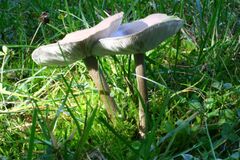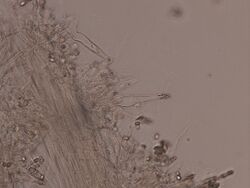Biology:Melanoleuca
| Melanoleuca | |
|---|---|

| |
| Melanoleuca cognata | |
| Scientific classification | |
| Kingdom: | |
| Division: | |
| Class: | |
| Order: | |
| Family: | |
| Genus: | Melanoleuca Pat. (1897)
|
| Type species | |
| Melanoleuca melaleuca (Persoon) Murrill (1911)
| |
| Synonyms[1][2] | |
| |
| Melanoleuca | |
|---|---|
| Mycological characteristics | |
| gills on hymenium | |
| cap is convex or depressed | |
| hymenium is adnate or adnexed | |
| stipe is bare | |
| spore print is white to cream | |
| ecology is saprotrophic | |
| edibility: edible or unknown | |
Melanoleuca is a poorly known genus of saprotrophic mushrooms traditionally classified in the family Tricholomataceae. Most are small to medium sized, white, brown, ocher or gray with a cylindrical to subcylindrical stipe and white to pale yellowish gills. The basidiospores are ellipsoid and ornamented with amyloid warts.[3][4][5] Melanoleuca is considered a difficult group to study due to their macroscopic similarities among species and the need of a thorough microscopic analysis to separate species.[6] DNA studies have determined that this genus is closely related to Amanita and Pluteus and that it does not belong to the family Tricholomataceae.[7][8]
Etymology
The name of the genus is derived from the Ancient Greek melano- meaning "black", and leukos meaning "white".
Description
General
As a genus Melanoleuca is quite distinctive, and it is not very hard to recognize a mushroom which belongs to it on sight. However the identification of its individual species is difficult due to a lack of clear macroscopic features; the delimiting characters used in descriptions and keys are such properties as the shape of cheilocystidia (if any are present), the size and ornamentation of the spores, and the structure of the pileipellis. Furthermore these characters may be very variable and overlap between taxa or depend on personal experience. Mycologists have up to now had considerable difficulty in establishing a widely accepted classification below the genus level.[9]
One recent paper dedicated to these mushrooms describes them as "one of the less appealing fungal genera" and "mostly tedious and drab in appearance and dull in pileus colours".[9]
Macroscopic characters
The fruit bodies of Melanoleuca are small to medium size (pileus 10–120 mm in diameter). The pileus is convex, often becoming depressed at the center, and is usually non-viscous and white, brown, ocher, or grey. The gills are adnexed, sinuate, adnate, or subdecurrent, white to yellowish. The stipe is central, cylindrical or slightly swollen at the base, dry and longitudinally striate. There is no veil. Odor and taste are usually indistinctive, mild, fungoid, sweet, or rancid. The spore print is white to pale yellowish.[4][5]
Microscopic characters

The spores of Melanoleuca are 7.0–11.0 x 4.0–6.0 µm, thin-walled, ellipsoid, amyloid with ornamented warts. They look very similar to the spores of Leucopaxillus, however, Melanoleuca spores present a plage. Basidia are usually 4-spored, cylindrical to clavate. Pleurocystidia and cheilocystidia may be present or absent; if present they are urticoid and thin-walled or fusiform to lageniform and thick-walled. They can have crystals incrusted at the apex. Cystidia are very important to separate species within this genus. The pileipellis is a trichoderm, sometimes a cutis. The hymenophoral trama is parallel. Clamp connections are absent in all parts of the fruit body.[4][5]
Classification and phylogeny
DNA studies have confirmed Melanoleuca as monophyletic (and definitely separate from genus Leucopaxillus, which is morphologically similar and previously thought to be allied).[9]
Other phylogenetic studies based on molecular characters have shown that Melanoleuca does not belong to the Tricholomataceae.[7][8] Moncalvo et al.[7] presented a molecular phylogeny of the Agaricales based on LSU ribosomal RNA sequence data, including sequences of M. alboflavida and M. cognata. In this phylogeny Melanoleuca was clustered with Pluteus but with low bootstrap support. Matheny et al.[8] performed a phylogenetic analysis of the Agaricales based on six-gene regions, including sequences of M. verrucipes. In this analysis Melanoleuca, Pluteus and Volvariella were recovered as a monophyletic group and closely related with the aquatic gasteromycete Limnoperdon. These three genera together with members of the Amanitaceae and Pleurotaceae conformed the Pluteoid clade. Garnica et al.[10] and Binder et al.[11] recovered a similar topology with Pluteus, Volvariella and Melanoleuca as a monophyletic group. Justo et al. performed a molecular phylogeny of the family Pluteaceae and found Melanoleuca to be the sister group to a clade composed of Pluteus and Volvopluteus.[12] This clade was poorly supported in their analysis.[12]
Habitat and Distribution
Melanoleuca species are saprotrophic; growing on soil in grasslands, deciduous and evergreen forests, and sand dunes.[4][6][13] They are cosmopolitan, but mainly distributed in temperate regions. Few species are known from the tropics.[4][14]
Edibility
Melanoleuca species are reported to be edible. The most common species that are consumed are M. alboflavida,[15] M. cognata, M. evenosa, and M. melaleuca.[4][16][17] Melanoleuca strictipes is reported to be slightly toxic.[13]
Species
Murrill[18] published the description of 119 species from North America, those species were revisited by Pfister[19] who concluded that only six belong in Melanoleuca, while the rest belong to other genera as Clitocybe or Tricholoma. Singer[4] considered 48 species worldwide, while Bon[5] recognized 65 species from Europe. Kirk et al.[20] consider about 50 species worldwide.
Representative species
- Melanoleuca abutyracea (Cleland) Grgur. – Found in Australia
- Melanoleuca alboflavida (Peck) Murrill with pileus pallid yellow brown to whitish. It is reported as edible.[17][21]
- Melanoleuca brevipes (Bull.) Pat. is recognized by a short and relatively thick stipe, which looks out of proportion with the broad pileus.[22]
- Melanoleuca cinereifolia (Bon) Bon is found in sand dunes, among Ammophila.[13]
- Melanoleuca cognata (Fr.) Konrad & Maubl. pileus brown to ochre with gills showing a distinct ochre to pinkish color. It is reported to be edible.[13][16]
- Melanoleuca communis Sánchez-García & Cifuentes is a species described from Mexico, found in coniferous or mixed forests, morphologically similar to M. polioleuca.[23]
- Melanoleuca evenosa (Sacc.) Konrad is a species usually found in coniferous forests, and often synonymized with M. subalpina and M. strictipes, it has a whitish pileus and lageniform cystidia.[13]
- Melanoleuca excissa (Fr.) Singer with urticoid and septate cystidia, often with crystals at the apex.[6]
- Melanoleuca grammopodia (Bull.) Fayod has a relatively long stipe and urticoid cystidia.[6]
- Melanoleuca melaleuca (Pers.) Murrill has been a very controversial species; some authors recognize this taxon as having cystidia, while some recognized it as not having cystidia. Fontenla et al.[24] put end to this discussion designating a neotype with cystidia.
- Melanoleuca polioleuca (Fr.) Kühner & Maire has been incorrectly named M. melaleuca. It has fusiform to lageniform cystidia.[22][lower-alpha 1]
- Melanoleuca privernensis (consiglio, Contu, Setti & Vizzini) Consiglio, Setti & Vizzini is the only species that has inamyloid spores.[2]
- Melanoleuca tucumanensis Singer is a species described from Tafí del Valle, Argentina [26]
- Melanoleuca verrucipes (Fr.) Singer is easy to recognize by a blackish dotted stipe.[6]
- Melanoleuca yucatanensis Guzman & Bon is a species described from tropical forests in Mexico, it has urticoid cystidia without apical crystals [14]
References
Footnotes
Citations
- ↑ "Synonyms: Melanoleuca Pat.". Index Fungorum. CAB International. http://www.speciesfungorum.org/Names/SynSpecies.asp?RecordID=18031.
- ↑ 2.0 2.1 "The agaricoid genus Kinia is a new member of the Pluteoid clade subordinate to Melanoleuca". Mycosphere 1 (2): 141–145. 2010. http://www.mycosphere.org/pdfs/MC1_2_No3.pdf.
- ↑ Métrod G. (1948). "Essai sur le genre Melanoleuca Patouillard emend". Bulletin de la Société Mycologique de France 64: 141–165.
- ↑ 4.0 4.1 4.2 4.3 4.4 4.5 4.6 Singer R. (1986). The Agaricales in Modern Taxonomy (4th ed.). Koenigstein Königstein im Taunus, Germany: Koeltz Scientific Books. ISBN 3-87429-254-1.
- ↑ 5.0 5.1 5.2 5.3 Bon M.. "Flore mycologique d'Europe, 2 - Les Tricholomes et ressemblants" (in fr). Documents Mycologiques Mémoire Hors Series 2 (ii): 1–163.
- ↑ 6.0 6.1 6.2 6.3 6.4 Boekhout T. (1988). "Notulae ad floram agaricinam neerlandicam- XVI. New taxa, new combinations in Melanoleuca Pat. and notes on rare species in the Netherlands". Persoonia 13 (4): 397–431.
- ↑ 7.0 7.1 7.2 "One hundred and seventeen clades of euagarics". Molecular Phylogenetics and Evolution 23 (3): 357–400. 2002. doi:10.1016/S1055-7903(02)00027-1. PMID 12099793. http://www.umich.edu/~mycology/publications_assets/moncalvo.mpe.2002.pdf.
- ↑ 8.0 8.1 8.2 "Major clades of Agaricales: A multilocus phylogenetic overview". Mycologia 98 (6): 982–985. 2006. doi:10.3852/mycologia.98.6.982. PMID 17486974. http://www.bio.utk.edu/matheny/Site/Publications_files/Mathenyetal_Agaricales_2006.pdf.
- ↑ 9.0 9.1 9.2 "A preliminary ITS phylogeny of Melanoleuca (Agaricales), with special reference to European taxa". Mycotaxon 118 (2): 361–381. 2011. doi:10.5248/118.361.
- ↑ "Reconstructing the evolution of agarics from nuclear gene sequences and basidiospore ultrastructure". Mycological Research 111 (9): 1019–1029. 2007. doi:10.1016/j.mycres.2007.03.019. PMID 18022533.
- ↑ "Amylocorticiales ord. nov. and Jaapiales ord. nov.: early diverging clades of agaricomycetidae dominated by corticioid forms". Mycologia 102 (4): 865–880. 2010. doi:10.3852/09-288. PMID 20648753.
- ↑ 12.0 12.1 "Phylogeny of the Pluteaceae (Agaricales, Basidiomycota): Taxonomy and character evolution". Fungal Biology 115 (1): 1–20. 2011. doi:10.1016/j.funbio.2010.09.012. PMID 21215950. https://iris.unito.it/bitstream/2318/74776/1/Phylogeny%20of%20the%20Pluteaceae_4aperto.pdf.
- ↑ 13.0 13.1 13.2 13.3 13.4 Vesterholt J. (2012). "Melanoleuca". in Knudsen H.. Funga nordica: agaricoid, boletoid and cyphelloid genera (2nd ed.). Copenhagen: Nordsvamp. pp. 477–481. ISBN 9788798396130.
- ↑ 14.0 14.1 Guzmán G. (1982). "New species of fungi form the Yucatan peninsula". Mycotaxon 16 (1).
- ↑ Phillips, Roger (2010). Mushrooms and Other Fungi of North America. Buffalo, NY: Firefly Books. p. 57. ISBN 978-1-55407-651-2.
- ↑ 16.0 16.1 Arora D. (1986). Mushrooms Demystified: A Comprehensive Guide to the Fleshy Fungi (2nd ed.). Berkeley: Ten Speed Press. ISBN 978-0898151695. https://archive.org/details/mushroomsdemysti00aror_0.
- ↑ 17.0 17.1 Mushrooms of northeastern North America (1st ed.). Syracuse, N.Y.: Syracuse University Press. 1997. ISBN 978-0815603887.
- ↑ Murrill WA. "Melanoleuca". North American Flora 10: 3–32.
- ↑ Pfister J. (1984). "Etudes des types de Peck et de Murrill appartenant ou ayant appartenu au genre Melanoleuca" (in fr). Mycotaxon 19: 101–132.
- ↑ Ainsworth & Bisby's dictionary of the fungi (10th ed.). Wallingford, Oxon, UK: CABI. 2008. ISBN 9780851998268.
- ↑ "A study of the boreal, alpine, and arctic species of Melanoleuca". Mycologia 69 (5): 927–951. 1977. doi:10.2307/3758777.
- ↑ 22.0 22.1 British fungus flora. Edinburgh: Royal Botanic Garden. 1998. ISBN 978-1872291826.
- ↑ "Revisión taxonómica del género Melanoleuca en México y descripción de especies nuevas" (in es). Revista Mexicana de Biodiversidad 84 (Suplemento-Micologia): 111–127. 2013. doi:10.7550/rmb.31569. http://www.ib.unam.mx/m/revista/pdfs/08-_S1128.pdf.
- ↑ Osservazioni sul genere Melanoleuca. Fungi non deliniati. 25. Edizioni Candusso. 2003.
- ↑ Phillips, Roger (2010). Mushrooms and Other Fungi of North America. Buffalo, NY: Firefly Books. p. 58. ISBN 978-1-55407-651-2.
- ↑ "Pródromo de la Flora Agaricina Argentina" (in fr). Lilloa 25: 5–461. 1952.
External links
Wikidata ☰ Q588312 entry
 |


